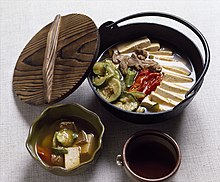Jeongol
 Tofu jeongol (dubu-jeongol; top and in left bowl) | |
| Type | Hot pot |
|---|---|
| Place of origin | Korea |
| Region or state | East Asia |
| Main ingredients | Various |
| Similar dishes | Nabe |
| Korean name | |
| Hangul | 전골 |
|---|---|
| Revised Romanization | jeongol |
| McCune–Reischauer | chŏn'gol |
| IPA | [tɕʌn.ɡol] |
 |
| This article is part of a series on |
| Korean cuisine 한국 요리 조선 료리 |
|---|
Jeongol (Korean: 전골) is a Korean-style hot pot made by putting meat, mushroom, seafood, seasoning, etc., in a stew pot, adding broth, and boiling it.[1] It is similar to the category of Korean stews called jjigae, with the main difference being that jjigae are generally made with only a single main ingredient, and named after that ingredient (such as kimchi jjigae or sundubu jjigae), while jeongol usually contain a variety of main ingredients.[2] An additional difference is that jeongol (like gujeolpan) was originally a dish for upper-class Koreans and members of the royal court, while jjigae was a simpler dish for commoners.[3]
History[edit]
According to the late Joseon era book Manguksamulkiwon Yeoksa (만국사물기원역사; 萬國事物紀原歷史; lit. The History of Various Objects From Around the World), jeongol originated from ancient times when soldiers would cook their food in iron helmets during times of war for lack of cooking utensils.[4][2][5] In other Joseon era documents such as Kyeongdo Jabji (경도잡지; 京都雜志), it is mentioned that jeongol was cooked in a vessel called jeolliptu (전립투; lit. soldier's hat) because it resembled a soldier's helmet. In Siuijeonseo, it is mentioned that thinly sliced seasoned beef was cooked in a pot and sprinkled with pine nut powder, and occasionally cooked with bamboo shoots, baby octopus and oysters.[2]
Preparation[edit]
Jeongol usually contains sliced beef or seafood, vegetables, mushrooms, and other seasonings, which are boiled with a small amount of broth in a jeongolteul (전골틀, pot used for cooking jeongol). They may also include mandu (dumplings). Some jeongol are spicy, containing added gochujang or chili pepper powder, although these ingredients may be omitted. The variety of broth used varies according to the type of jeongol being prepared.[2]
Varieties[edit]
- Beoseot jeongol (버섯전골) - made with mushrooms[6]
- Bosin jeongol (보신전골) - made with dog meat
- Dubu jeongol (두부전골) - made with tofu[6]
- Gaksaek jeongol (각색전골) - made with various ingredients.[7]
- Gopchang jeongol (곱창전골) - made with beef offal[6]
- Haemul jeongol (해물전골) - made with seafood[6]
- Mandu jeongol (만두전골) - made with mandu[8][9][10]
- Nakji jeongol (낙지전골) - made with small octopus[6]
- Sinseollo (신선로) - a variety of jeongol formerly served in Korean royal court cuisine[6]
- Sogogi jeongol (소고기전골) - made with beef but no seafood[6]
See also[edit]
- Jjigae, another category of stew from Korea
- Hot pot
- Nabemono, a similar variety of dishes from Japan
- Oden
- Pot-au-feu
- Thai suki
- Korean royal court cuisine
- List of casserole dishes
- List of Korean dishes
- List of soups
References[edit]
- ^ "전골". Basic Korean Dictionary. National Institute of Korean Language. Retrieved 2017-02-19.
- ^ a b c d (in Korean) Jeongol Archived 2011-06-10 at the Wayback Machine at Encyclopedia of Korean Culture
- ^ (in Korean) Jeongol at Doosan Encyclopedia
- ^ (in Korean) Manguksamulkiwon Yeoksa Archived 2011-06-10 at the Wayback Machine at Encyclopedia of Korean Culture
- ^ "jeongol". 2011-06-10. Archived from the original on 2011-06-10. Retrieved 2019-05-23.
- ^ a b c d e f g (in Korean) Jeongol Archived 2011-06-10 at the Wayback Machine t Britannica Korea
- ^ (in Korean) Gaksaek jeongol at Doosan Encyclopedia
- ^ Kim Hyeong-woo (김형우) (2006-11-08). 만두집 '다락정' (in Korean). Chosun Ilbo. Archived from the original on 2014-08-14. Retrieved 2009-03-18.
- ^ Park Je-seong (박제성) (2007-09-06). 샐러리맨의 만찬]삼선교·양재동 ‘하단’ (in Korean). Kyunghyang Sinmun.
- ^ Gwon Se-jin (권세진) (2006-11-16). 겨울철 별미 만두 맛있는 집 (in Korean). Sekye Ilbo.
External links[edit]
 Media related to Jeongol at Wikimedia Commons
Media related to Jeongol at Wikimedia Commons
